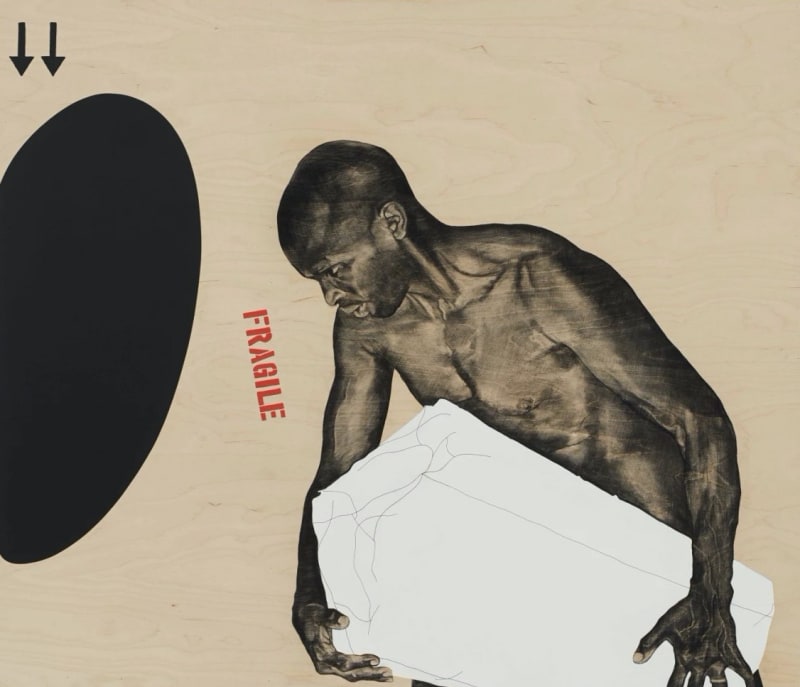BY NKGOPOLENG MOLOI
What was the place like before it was named?
This question permeates and lives in the atmosphere. Often, naming indicates the beginning of a boundary – an edge around which a label encircles. Ultimately, the process of naming is about enclosure, defining conditions of existence within a space and demarcations that determine belonging.
Serge Alain Nitegeka’s ‘Lost and Found’ is a site for reading patterns of migrations through narratives of shifting homelands and travelling identities. Using sculpture and paintings Nitegeka explores experiences of forced migration. Canvas is stretched, tightly bound around cardboard and stitched into objects of journeying. Egg-shaped and rectangular lumps whose contents remain a mystery are placed on wooden base ‘platforms’, conjuring up the image of a sojourner travelling through a railway platform on the precipice of a voyage. Throughout the exhibition, Nitegeka’s exacting language of abstraction for which he is lauded (and which was the basis of his last three shows: ‘Innate Black’, ‘Ode to Black’ and ‘Black Passage’) is present and yet we also experience the return of the figure through the black body rendered in charcoal and paint on wood. In this sense, ‘Lost and Found’ diverges from the methods of the last three shows which can be read as inquiries into the imaginary and philosophical concepts of the colour black. Explaining this divergence, Nitegeka notes, ‘I wanted to position my longstanding investigations into forced migration in a more direct and decisive engagement with the viewer, and in contrast to abstraction.’ He elaborates further, ‘when the viewer sees a black body in the nude carrying what appears to be a heavy load, a few narratives may be evoked – among them; human trafficking and slavery. Furthermore, as the viewer digs deeper, hopefully along this trajectory, the main narratives will come to the fore. It is hard to stage and facilitate such an inquiry using abstraction as a tool.’
There is a coherent and uninterrupted relationship between the paintings and the sculptures in the exhibition, where paintings are performed as sculptures and sculptures are performed as paintings. Lost and Found II (sculpture) is animated through Identity is Fragile I (painting); Identity is Fragile IV (painting) is animated through Lost and Found V (sculpture). The composition of the exhibition in its entirety seems to float between parallels and contrasts. For instance, we see the rigidity of borders against the flow of movement as well as the elasticity of canvas against its resistance. On the use of canvas as a material from which to form the containers, Nitegeka notes; ‘[canvas] is an artist’s first area of exploration, as far as painting goes. I wanted to see what else canvas could do. It is a tough and versatile material used as a roof cover for convertible cars and in wrestling & boxing arenas. I [wanted] it to reference the bedsheets and blankets I once saw people store and carry their belongings in.’ The parallels and contradictions contained in ‘Lost and Found’ mirror the complex paradoxes that exist within narratives of migration where discordance, incongruity and disorientation are known to be migration’s inevitable concomitants.
These contradictions function as openings and create space for varying possibilities of readings, as captured by post-structuralists Deleuze and Guattari in their 1980 book, A Thousand Plateaus: Capitalism and Schizophrenia, noting:
The map is open and connectable in all its dimensions; it is detachable, reversible, susceptible to constant modification. It can be torn, reversed, adapted to any kind of mounting, reworked by an individual, group, or social formation. It can be drawn on the wall, conceived of as a work of art, constructed as a political action or as a meditation.
In The Occasion for Speaking, West-Indian novelist George Lamming writes, ‘the pleasure and paradox of my own exile is that I belong wherever I am.’ Lamming presents us with a view of the world as both open and closed where movement can be sanctioned (exile) and/or desired, desirable and pleasurable. Through this view of pleasures and paradoxes of exile, the map is affirmed as both a tool of inflexibility and exclusion on one hand – cartographic enclosures – while also functioning as a possible instrument for freedom. Mobility as freedom but also as flight. In ‘Lost and Found’, we are not privy to the conditions that led to the migration of Nitegeka’s protagonists. In the same vein, we are in the dark about what it is they have chosen to take with them on the journey as the contents of the covered vessels remain hidden. It is impossible to map out the full narrative of these Black bodies in space.
As demonstrated in his previous exhibitions, Nitegeka is effective at employing allegory – where colour and shape stood in for political discourse. In this exhibition, the story of migration which originates from the mythology of cartographies is not told through maps and lines but rather through wrapped bundles of moveable possessions holding memories. Screenwriter Bhekizizwe Peterson points us to the notion of the ‘experiential archive’ which is an archive stored in suitcases, plastic bags under beds, wardrobes and in ceilings. Similarly, Nitegeka’s improvised containers point us to readable and movable archives carrying the traveller’s most important possessions where the archive functions as a proxy for memories of what is left behind.
The idea that what is lost can be found is hopeful. And therefore this exhibition is hopeful. When thinking about displacement and forced migrations, it is quite easy to conceive of what it lost ‘– livelihoods, family, friends. What is more difficult to imagine is what can be found. The condition of the migrant is necessarily a difficult one. But of course, through the process of moving from and moving towards, there is a possibility of dreams and richer ways of existing and relating through circulation, blending, harmonizing.


